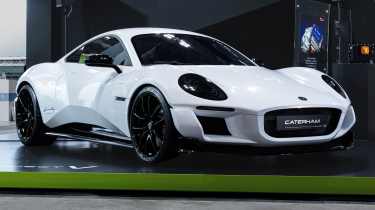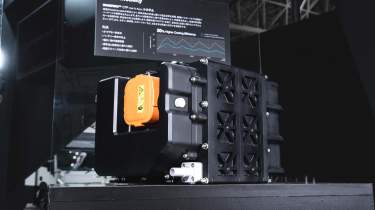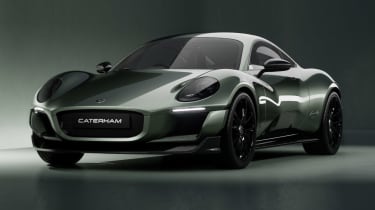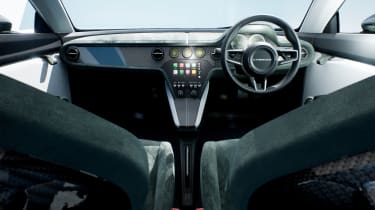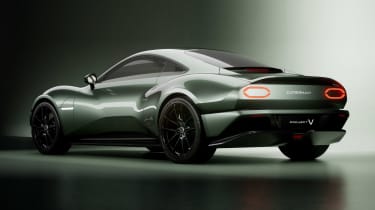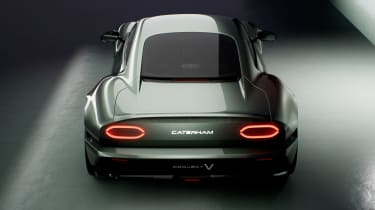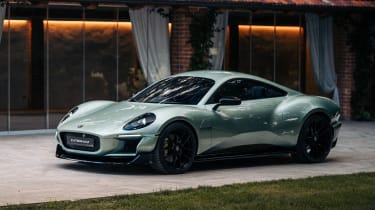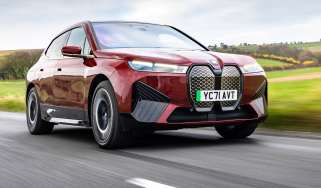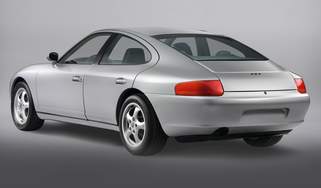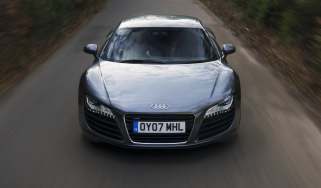The Caterham Project V is Britain's answer to the electric Porsche Cayman
Caterham’s new age electric coupe will pack Yamaha powertrain tech and liquid-cooled batteries, with development due to be completed later this year
As development for Caterham's upcoming electric sports car, the Project V, edges towards completion later this year, the model has been shown at the Tokyo Auto Salon in its latest form. Taiwan-based battery supplier Xing Mobility has joined Yamaha and Tokyo R&D as a technical partner, helping bring the car to market. Under the ownership of Japanese car retail giant VT Holdings, the model is being conceived as a battery-powered coupe to rival Porsche’s forthcoming electric 718 Cayman, and will pack Yamaha powertrain technology to deliver the kind of performance and ability expected of a Caterham.
The Project V shares nothing with the Seven, which has sustained the iconic British sports car maker for 50 years, save for a few subtle styling hints and, crucially, the company’s philosophy: lightweight, simple, fun to drive. It’s been designed by Anthony Jannarelly and the show car in these pictures has been engineered and manufactured by ItalDesign. A production facility for the road car hasn't been finalised yet, but various locations are under consideration.
The new model will be rear-wheel drive and powered by two battery packs: one in front of the rear axle and another under the floor in the front footwells. While battery details were under initially under wraps, Caterham has also now confirmed that these packs will be supplied by Taiwan-based Xing Mobility, making use of its immersion liquid cooling technology for optimum heat management and power density.
Royce Hong, Founder and CEO of XING Mobility, said: 'As a longtime Caterham 7 owner and enthusiast, it is an incredible honor for us to collaborate with Caterham on this pivotal step in their electrification journey. Caterham's philosophy of simplicity and lightweight design perfectly aligns with our vision for innovation, simplicity, and efficiency. We are confident this partnership will open a new chapter for the electric driving experience.'
Having initially favoured an extruded and bonded aluminium structure, Caterham is now looking at a blend of aluminium, carbonfibre and glassfibre due to the significant weight saving it offers. The quoted weight is 1190kg (with fluids), and the rear-mounted Yamaha e-axle will generate 268bhp; good for a 0-62mph time ‘in the low 4s’ and a maximum of ‘above 230kph’ (143mph). According to Bob Laishley, Caterham’s CEO, prices will start at ‘under £80k’.
Laishley joined Caterham as chief strategic officer on a part-time basis back in April 2021 when VT Holdings bought the British company. He took over as CEO in 2022 and has overseen Project V, which is seen as crucial to the company’s future. ‘The Caterham Seven is 50 years old; the design is 60 years old,’ he says. ‘If Caterham is to survive as a brand, it needs to evolve.’
In 2023, we signed an NDA and were invited to ItalDesign in Turin to be the first to see the new car. It’s not the first time Caterham has set out to create a new model, of course, notable attempts being the 21 and the CSR. To be greeted by Laishley in the striking entrance hall of ItalDesign, with its long, white staircase and classical pillars, suggests that this time it’s aiming higher and that its ambition has more substantial financial foundations.
Consideration was given to re-engineering one or two existing sports cars with an EV powertrain before the decision was made to start with a clean sheet. Six design houses and individuals were invited to submit proposals for what a new Caterham should be, guided by a three-page brief that said it was an EV, mentioned performance targets and named a few iconic cars to inspire it. These included the original Lotus Elan, a favourite of VT Holdings’ president Kazuho Takahashi. The brief didn’t ask for a finished design but to describe the journey from the Seven to a new Caterham, and the winning submission was from Anthony Jannarelly, co-founder of Jannarelly Automotive, whose first car, the Design-1, featured in evo 276 and 279.
ItalDesign won the contract to engineer and manufacture the show car and Jannarelly was there to talk us through the design and get feedback. (A few weeks later he was announced as Caterham’s head of design.)
On a large screen in a darkened auditorium, a cursor picks a file and a moment later the new Caterham is on the screen, finished in light green and digitally rendered in a street setting. The viewpoint shifts from front three-quarters, moving around to show the profile and now the rear. Wow! My initial reaction is that I love the curves, the almost individual pontoon look for each wheel. And it looks so low and muscular. It’s quite a retro, almost ’60s look for a 2020s car, but I think it will stand out in the EV marketplace, like a tantalising dessert in a market full of stodgy main courses.
Jannarelly explains that some of the elements are inspired by the Seven: the mouth is the shape of the Seven grille, the swage lines converging on the door are to evoke the Seven’s door aperture, and the flat rear panel references the simple rear of the Seven too. It doesn’t need these visual clues but it’s not an issue because they don’t compromise the look. The front end reminds me of another car and it only dawns on me hours later that it’s the Jaguar C‑X75.
We get the chance to experience it in 3D with the help of a virtual reality headset, which allows you to lean in through the roof and see the simple, neat interior. I’m not convinced by the two-plus-one interior concept which sits a (small) rear passenger centrally, although, as in a 911, the rear seat space will probably get used for luggage (a 2+2 will also be an option). One great idea is the use of reskinned doors from the Audi TT rather than engineering new ones from scratch. Laishley convinced the board of VT Holdings that this was a sensible thing to do by taking them to the Maserati showroom across from their head office and showing them the amount of detail in the frameless door seal of an MC20.
By the time of our visit in March, the shape was largely fixed – the first freeze of the glasshouse and shuts was in January – but there was still lots to be decided. We were invited to offer an opinion on the exact shade of green the show car should be finished in, what material the interior should be trimmed in and the choice of wheel. All need to be decided so that ItalDesign can get on with creating the show car to be ready in time for Goodwood.
On May 25 2023, we headed back to ItalDesign to see the final show car that would be revealed to the public. We were joined by engineering consultant David Twohig. He and Bob go back a long way, from Nissan days. He’s a valuable ‘sanity check’ on the project, his CV including chief engineer on the Renault Zoe, Alpine A110 and Byton M-Byte. Bob reckons he’s one of the top five engineering consultants in the world.
We made our way to a different part of the ItalDesign factory this time, to a design studio to see the full-size model of Project V. It was the first time it'd been on its wheels, so this was quite a moment. We saw it head-on as we enter and the smoothness of the nose and the rounded, tumblehome of the roof suggests the early ’70s Opel GT coupe to me.
Sitting there, it’s hard to get the scale. I ask Jannarelly how it compares with a Cayman. It’s not far off, he says, ‘A little lower, a little wider, about the same length.’ A Cayman that’s been under a rolling pin, then. I wasn’t convinced by the ‘Seven’ mouth last time. Here, standing in front of it, I have no issue. ‘Photographers will kneel and get a more dynamic angle but this is how people will really see it,’ says a thoughtful Jannarelly. I’m still more of a fan of the rear, particularly the rear screen and bootlid area, where the rear haunches and the vestigial buttresses come together beautifully.
The front wheels need a bit of camber and are sitting 5mm too low in the arches, says Twohig, but he’s impressed. ‘What ItalDesign has done in the time, with the budget, is incredible,’ he says.
There’s a seat inside, and a dashboard and wheel. An ItalDesign staffer tries to get Jannarelly over to be the first person outside of ItalDesign to sit in it, but he’s deep in conversation at the back of the car. I step forward for a closer look and get invited to sit inside. I don’t need asking twice.
The seat is from a Maserati MC20 and has no cover over the foam cushion yet, but it is powered. Where the front battery sits, below the footwell, you can see the floor rise gradually against the sill. This is to get the H-point (driver’s hip point) as low as possible, explains Laishley.
There are two pedals, floor-hinged Tiltons that look offset to the right. But, having whirred the seat into place, I find the driving position perfectly aligned and the wheel perfectly placed. It’s narrower in here than I expected, the window line quite high, but not cramped. The facia looks great: simple, and somehow ’60s American. The steering wheel is as small as you’d want it diameter-wise, and in production will offer height and reach adjustment. Set to its mid-point, it’s spot on for me. The three dials in the centre will include a clock and a drive mode indicator. Normal, Sport and Sprint will be offered, the latter sacrificing range for maximum performance. There will be a screen in the centre but no software – your phone will provide satnav, and music via Bluetooth speakers in the doors.
‘Current battery height is 120mm,’ says Laishley. ‘We’ve seen plenty of future developments that say battery height will get down to 80mm, maybe even as low as 60mm. We’ve packaged for 80mm.’ He sees the opportunity to differentiate between versions of Project V by offering customers different battery packs: a pack that can charge and discharge quickly for ultimate performance, another for longer range (c250 miles on the WLTP cycle). They haven’t settled on a supplier yet, but they will need to have decided by next spring because development will need to begin on systems that will require small volume approval. Things like anti-lock brakes, airbags and the like. It will only be what is strictly necessary. ‘We want the minimum amount in this vehicle to make it compliant, and that’s purely to drive down the weight,’ says Laishley. ‘The project will be properly funded – it will be tight, a fraction of what McLaren or Aston would spend.’
The car you see is what will go into production, give or take a spoiler edge here, a door mirror there. ‘We’re a small company. We can’t afford the luxury of making a styling model and then grind it up and throw it away after it’s got some headlines,’ says Laishley. ‘We wanted this to be as close as possible to the car we want to make in production, so there’s been a lot more consideration of engineering.’
There’s undoubtedly space in the market for a car like Project V. We’ve seen announcements of many £1m, 2000bhp EV supercars but arguably no genuine sports cars since the Tesla Roadster. The market is hotting up, though, with electric sports cars from Alpine and Lotus and Porsche’s 718 EV on the horizon. We suspect these will be a little more mainstream than the Project V: perhaps a bit heavier, a bit more everyday-biased. So it rests with Caterham to hit its bold weight targets and deliver a unique EV: one that is ‘lightweight, simple and fun to drive’. If they manage that, we reckon it will be a winner.
